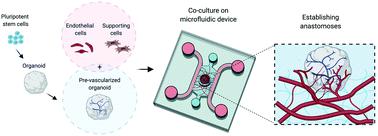Our official English website, www.x-mol.net, welcomes your
feedback! (Note: you will need to create a separate account there.)
Vascularized organoids on a chip: strategies for engineering organoids with functional vasculature
Lab on a Chip ( IF 6.1 ) Pub Date : 2021-1-15 , DOI: 10.1039/d0lc01186j
Shun Zhang 1 , Zhengpeng Wan 1 , Roger D Kamm 1
Lab on a Chip ( IF 6.1 ) Pub Date : 2021-1-15 , DOI: 10.1039/d0lc01186j
Shun Zhang 1 , Zhengpeng Wan 1 , Roger D Kamm 1
Affiliation

|
Human organoids, self-organized and differentiated from homogenous pluripotent stem cells (PSC), replicate the key structural and functional characteristics of their in vivo counterparts. Despite the rapid advancement of organoid technology and its diverse applications, major limitations in achieving truly in vivo like functionality have been the lack of matured structural organization and constraints on tissue size, both of which are direct consequences of lacking a functional vasculature. In the absence of perfusable vessels, a core region within organoids quickly becomes necrotic during development due to increased metabolic demands that cannot be met by diffusion alone. Thus, incorporating functional vasculature in organoid models is indispensable for their growth in excess of several hundred microns and maturaturation beyond the embryonic and fetal phase. Here, we review recent advancements in vascularizing organoids and engineering in vitro capillary beds, and further explore strategies to integrate them on a microfluidic based platform, aiming for establishing perfused vasculature throughout organoids in vitro.
中文翻译:

芯片上的血管化类器官:具有功能性脉管系统的工程类器官的策略
人类类器官是自组织的,并由同质多能干细胞(PSC)分化而来,复制了体内对应物的关键结构和功能特征。尽管类器官技术及其多样化的应用迅速发展,但实现真正的体内类似功能的主要限制是缺乏成熟的结构组织和对组织尺寸的限制,这两者都是缺乏功能性脉管系统的直接后果。在缺乏可灌注血管的情况下,类器官内的核心区域在发育过程中很快就会坏死,因为代谢需求增加,而仅通过扩散无法满足这一需求。因此,将功能性脉管系统纳入类器官模型对于其生长超过数百微米以及超越胚胎期和胎儿期的成熟是必不可少的。在这里,我们回顾了血管化类器官和体外毛细血管床工程的最新进展,并进一步探索将它们集成到基于微流体的平台上的策略,旨在在体外建立整个类器官的灌注脉管系统。
更新日期:2021-01-22
中文翻译:

芯片上的血管化类器官:具有功能性脉管系统的工程类器官的策略
人类类器官是自组织的,并由同质多能干细胞(PSC)分化而来,复制了体内对应物的关键结构和功能特征。尽管类器官技术及其多样化的应用迅速发展,但实现真正的体内类似功能的主要限制是缺乏成熟的结构组织和对组织尺寸的限制,这两者都是缺乏功能性脉管系统的直接后果。在缺乏可灌注血管的情况下,类器官内的核心区域在发育过程中很快就会坏死,因为代谢需求增加,而仅通过扩散无法满足这一需求。因此,将功能性脉管系统纳入类器官模型对于其生长超过数百微米以及超越胚胎期和胎儿期的成熟是必不可少的。在这里,我们回顾了血管化类器官和体外毛细血管床工程的最新进展,并进一步探索将它们集成到基于微流体的平台上的策略,旨在在体外建立整个类器官的灌注脉管系统。

































 京公网安备 11010802027423号
京公网安备 11010802027423号